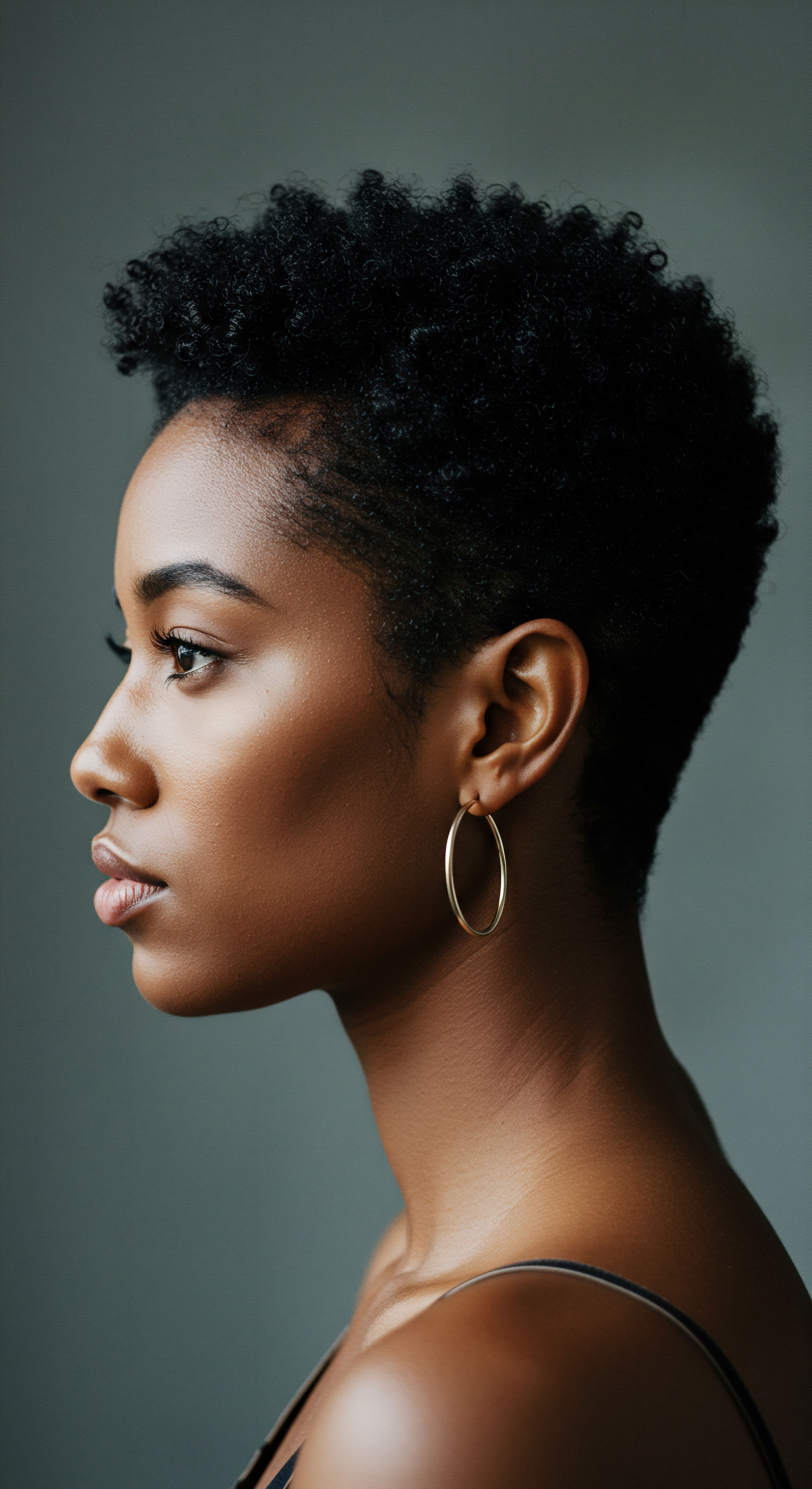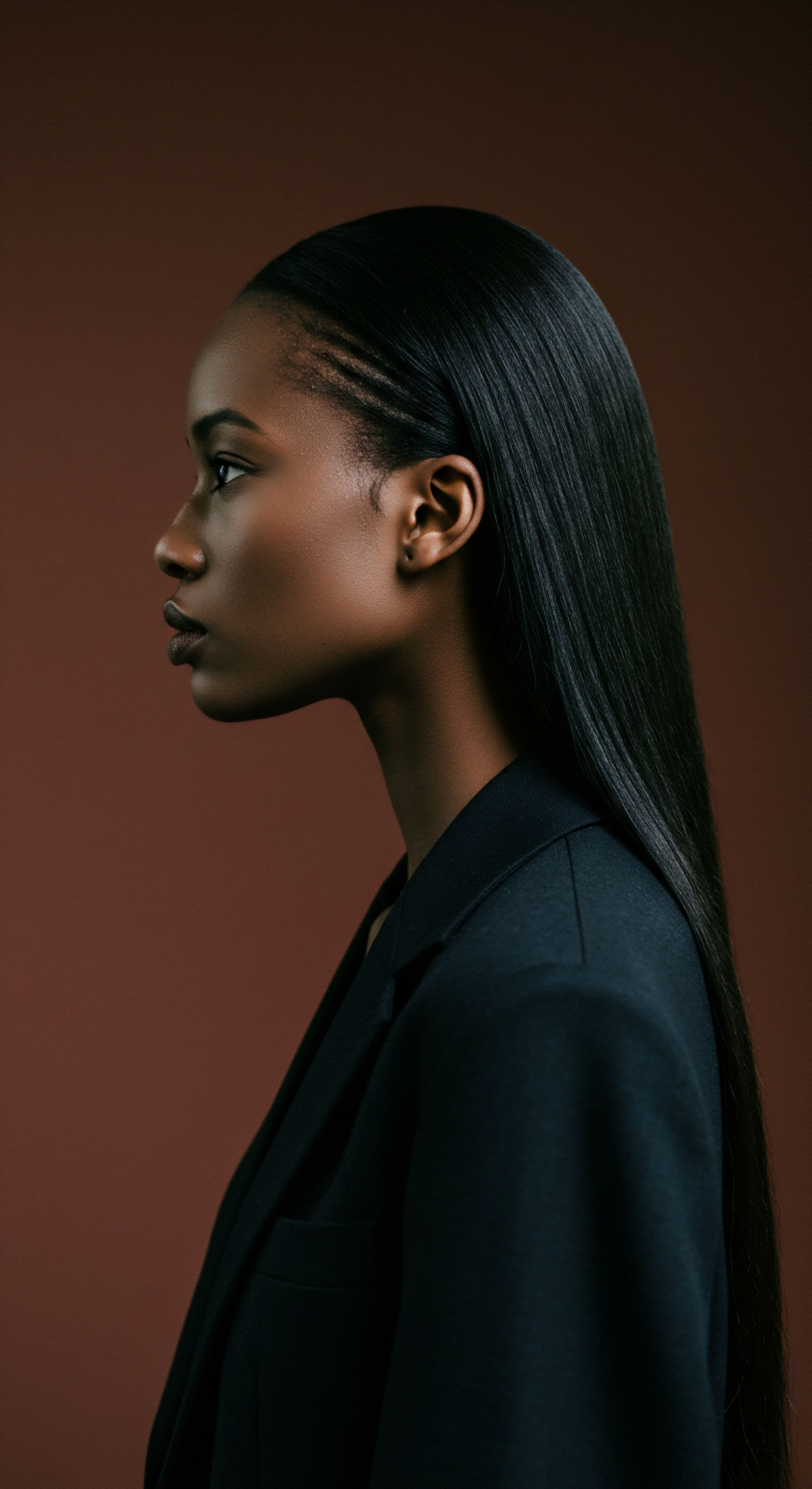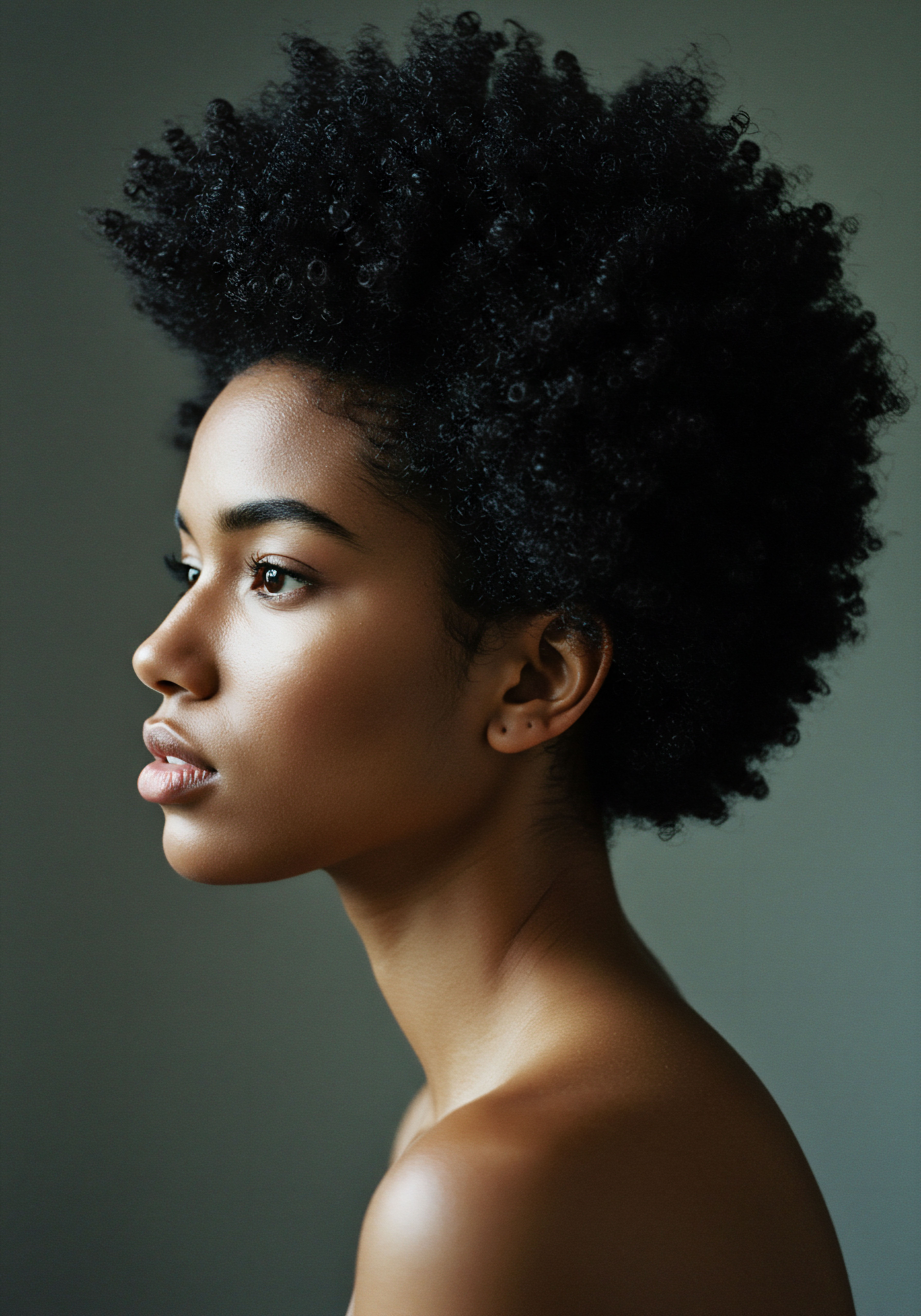
Roots
There are quiet whispers woven into the very fabric of our being, subtle currents that guide the story of our hair, particularly at its most tender edge—the hairline. For many, this delicate boundary is a barometer, reflecting shifts both seen and unseen. We often focus on what is visible ❉ breakage, thinning, or a changing silhouette.
Yet, beneath the surface of daily rituals and styling choices, a deeper symphony of influences plays, orchestrating the hairline’s sensitive evolution. To truly understand its gentle undulations and persistent challenges, we must first turn our gaze inward, to the foundational principles that shape every strand and every follicle.

The Follicle’s Quiet Life
The hairline is a collection of hair follicles, each a tiny, complex organ with a life cycle all its own. These microscopic structures, nestled just beneath the skin’s surface, are far more than simple anchors for our strands. They are dynamic hubs of cellular activity, constantly engaged in a rhythmic dance of growth, rest, and renewal.
Each follicle possesses its own miniature ecosystem, responding to a myriad of signals from within the body and the world around it. When the hairline seems to recede or thin, it is often a signal that this delicate follicular balance has been disturbed, not merely a surface-level cosmetic concern.
Understanding the life of a single hair follicle begins with its architecture. The dermal papilla, a small, nipple-like protrusion at the base of the follicle, contains the capillaries that nourish the growing hair. Surrounding it are matrix cells, rapidly dividing to produce the hair shaft. This intricate interplay dictates the strength, texture, and density of the hair that emerges.
At the hairline, these follicles can be particularly vulnerable, often being finer and more susceptible to external pressures and internal shifts. Their delicate nature makes them early indicators of systemic changes or localized stresses.

Hair Growth Cycles and Their Rhythms
Every hair follicle cycles through distinct phases ❉ anagen (growth), catagen (transition), and telogen (rest). The duration of these phases varies from person to person and across different areas of the scalp. For the hair along the hairline, the anagen phase—the period of active growth—can sometimes be shorter compared to other regions of the scalp. This natural variation means that hairs at the hairline may not grow as long or as thick, making them inherently more delicate and prone to visible changes.
- Anagen ❉ The active growth phase, lasting from two to seven years, during which hair cells rapidly divide and hair grows.
- Catagen ❉ A short transitional phase, lasting about two to three weeks, where hair growth stops and the outer root sheath shrinks.
- Telogen ❉ The resting phase, lasting around two to four months, after which the old hair sheds and a new anagen hair begins to grow.
Disruptions to this cycle, even subtle ones, can manifest as noticeable thinning or recession along the hairline. When a disproportionate number of follicles enter the telogen phase prematurely, or if the anagen phase shortens significantly, the density at the hairline can diminish. This often points to deeper influences, acting as silent conductors of the hair’s follicular orchestra.

Does Hairline Texture Differ from Scalp Hair?
Indeed, the hair at the hairline often presents with a finer texture and a different curl pattern than the hair on the crown or other areas of the scalp. This distinction is not merely anecdotal; it is rooted in variations in follicular structure and density. Hairline follicles can be smaller, producing strands with a reduced diameter and sometimes a looser coil. This inherent fineness makes these hairs more susceptible to damage from manipulation, tension, and environmental elements.
For those with textured hair, this difference can be particularly pronounced. The delicate coils at the hairline may possess fewer cuticle layers or a more open cuticle, leading to increased porosity and a greater propensity for moisture loss. This structural vulnerability means that external stressors, which might be absorbed by thicker hair elsewhere, can have a disproportionately greater impact on the hairline, leading to visible changes in its appearance and density over time.

Ritual
Our daily interactions with our hair, from the gentle touch of a comb to the protective wrap of a scarf, form a sequence of rituals that shape its journey. While many of these practices are intended to nurture and adorn, they can, without conscious consideration, exert unseen pressures on the sensitive hairline. Understanding these subtle dynamics within our routine is paramount, for the wisdom of hair care lies not just in what we do, but in how we do it, and the mindful awareness we bring to each gesture. This section seeks to shed light on the often-overlooked practicalities that silently influence the hairline’s vitality.

The Weight of Styling Practices
The art of styling textured hair often involves techniques that apply tension. From braids and twists to sleek updos, these styles, while beautiful and protective, can become silent adversaries to the hairline if not executed with a gentle hand. The consistent pulling, especially when styling too tightly or maintaining styles for extended periods, can lead to a condition known as traction alopecia. This is a progressive form of hair loss caused by chronic tension on the hair follicle, often manifesting as thinning or recession along the hairline.
Consider the daily act of pulling hair back into a ponytail or bun. Even seemingly loose styles can exert continuous pressure on the delicate perimeter strands. Over time, this repetitive stress can weaken the follicles, leading to a diminished capacity for healthy growth.
It is a slow, quiet erosion, often unnoticed until significant changes become apparent. The choice of styling tools also plays a role; brushes with stiff bristles or combs with sharp teeth can snag and pull, causing mechanical damage that further compromises the hairline’s integrity.
Gentle styling, particularly at the hairline, serves as a shield against unseen pressures that can compromise follicular health.

The Silent Influence of Hair Products
The potions and elixirs we apply to our hair are chosen with care, often promising shine, moisture, or strength. Yet, the chemical composition of these products, and how they interact with our skin and hair, can carry unseen consequences for the sensitive hairline. Ingredients that are overly harsh, drying, or comedogenic (pore-clogging) can disrupt the delicate balance of the scalp’s microbiome and irritate the follicular environment.
For instance, products containing high concentrations of alcohols can strip the hair and scalp of natural oils, leading to dryness and brittleness at the hairline. Similarly, heavy waxes or petroleum-based products, while offering hold, can create a barrier that traps sweat and debris, potentially clogging follicles and impeding healthy growth. The repeated application of edge controls, often designed for strong hold, can also contribute to this issue, especially if not thoroughly cleansed from the scalp, leading to build-up and irritation.
| Ingredient Type Alcohols (e.g. Ethanol, Isopropyl Alcohol) |
| Purpose Quick drying, light feel |
| Potential Hairline Influence Drying, brittleness, increased breakage risk |
| Ingredient Type Heavy Waxes/Petroleum Jelly |
| Purpose Strong hold, shine |
| Potential Hairline Influence Follicle clogging, build-up, irritation |
| Ingredient Type Fragrances/Dyes |
| Purpose Scent, color |
| Potential Hairline Influence Allergic reactions, scalp irritation, inflammation |
| Ingredient Type Sulfates (e.g. Sodium Lauryl Sulfate) |
| Purpose Cleansing, lathering |
| Potential Hairline Influence Excessive stripping of natural oils, dryness |
| Ingredient Type Understanding product ingredients can help in making informed choices for hairline care. |

The Nighttime Sanctuary and Unseen Friction
The hours of sleep, meant for rest and rejuvenation, can inadvertently become a source of subtle stress for the hairline. Cotton pillowcases, while soft to the touch, possess a fibrous texture that can create friction against delicate hair strands as we move during the night. This constant rubbing can lead to mechanical damage, causing breakage and thinning, particularly along the perimeter where hair is often finer and more exposed.
The wisdom of covering textured hair at night, often with a satin or silk bonnet, is not merely about preserving a style; it is a protective ritual against this unseen friction. These smooth fabrics allow hair to glide effortlessly, minimizing snags and reducing moisture loss. Without this protective barrier, the hairline is left vulnerable to the nightly abrasion, which, over months and years, can contribute to its gradual changes. The choice of sleep protection, therefore, is a quiet yet potent influence on the hairline’s long-term health.

Relay
Beyond the tangible rituals and the fundamental biology, a deeper current of influences shapes the sensitive hairline—a complex interplay of internal systemic signals, environmental whispers, and even the echoes of ancestral narratives. This section invites a more contemplative approach, examining the intricate connections that transcend the immediate and illuminate the subtle, yet powerful, forces at play. We will journey into the less-explored territories, where the hairline’s changes are not isolated events but rather reflections of a grander, interconnected story.

How Do Internal Stressors Impact Hairline Sensitivity?
The human body is a marvel of interconnected systems, and the state of our internal equilibrium profoundly influences the health of our hair. Stress, in its many forms—be it psychological, physiological, or environmental—acts as a potent conductor, orchestrating responses that can subtly, yet significantly, affect the hairline. When the body perceives stress, it releases a cascade of hormones, including cortisol.
Elevated levels of cortisol can disrupt the normal hair growth cycle, potentially pushing a greater number of follicles into the resting (telogen) phase prematurely. This phenomenon, known as telogen effluvium, often manifests as diffuse shedding, but its effects can be particularly noticeable and distressing along the delicate hairline.
Consider, for instance, the findings from a study published in the journal Stress in 2017. Researchers examined the impact of chronic psychological stress on hair growth and found that stress can lead to increased inflammation around hair follicles and a shortened anagen phase. One particular study involving a cohort experiencing prolonged stress demonstrated a statistically significant increase in the percentage of telogen hairs, with a notable prevalence of thinning along the frontal scalp and temples.
This suggests a direct physiological link between the body’s stress response and the vitality of the hairline, moving beyond anecdotal observation to a clearer, research-backed understanding. The body’s internal state is constantly communicating with its most outward expressions, and the hairline is a sensitive receiver of these profound messages.

The Gut-Hair Axis and Nutrient Flow
A burgeoning field of understanding points to the profound connection between our gut health and the vitality of our hair. The gut microbiome, a complex community of microorganisms residing in our digestive tract, plays a critical role in nutrient absorption, immune regulation, and the synthesis of various compounds essential for bodily functions. A dysbiotic gut, characterized by an imbalance of beneficial and harmful bacteria, can compromise the body’s ability to absorb vital vitamins and minerals necessary for robust hair growth.
Deficiencies in iron, zinc, biotin, and certain B vitamins are well-documented culprits in hair thinning and loss. If the gut is not functioning optimally, even a diet rich in these nutrients may not translate into adequate delivery to the hair follicles. The hairline, with its finer, more vulnerable strands, can be an early indicator of these systemic nutritional shortcomings.
Inflammation originating in the gut can also trigger a systemic inflammatory response, which can negatively impact hair follicle health, potentially leading to miniaturization and reduced density at the hairline. This interconnectedness highlights a holistic approach to hairline health, where nourishment begins not just on the scalp, but deep within the digestive system.
The subtle interplay of hormones, gut health, and environmental factors paints a comprehensive picture of hairline resilience.

Environmental Echoes and Unseen Particulates
Our external surroundings, often perceived as benign, hold a silent power over the hairline. Air pollution, for example, is no longer merely a concern for respiratory health; its microscopic particulate matter (PM) can settle on the scalp and hair, creating a layer of unseen stress. These pollutants, including heavy metals and polycyclic aromatic hydrocarbons (PAHs), can generate oxidative stress within the hair follicles. Oxidative stress, an imbalance between free radicals and antioxidants, can damage cellular structures, accelerate the aging process of follicles, and disrupt the hair growth cycle.
The hairline, being the most exposed perimeter, bears the brunt of this environmental assault. Constant exposure to these airborne irritants can lead to scalp inflammation, itching, and a compromised scalp barrier, all of which can contribute to weakened hair strands and a receding hairline. Furthermore, the water we use for washing, particularly if it is hard water with high mineral content, can leave mineral deposits on the hair and scalp. These deposits can build up, making hair brittle, dull, and more susceptible to breakage, with the finer hairline strands being particularly vulnerable to this cumulative effect.
- Particulate Matter ❉ Microscopic airborne particles that can settle on the scalp and hair, leading to oxidative stress and follicle damage.
- Hard Water Minerals ❉ Calcium and magnesium deposits from water can accumulate on hair, causing brittleness and increased breakage risk.
- UV Radiation ❉ Prolonged sun exposure can degrade hair proteins and lipids, weakening strands and potentially affecting follicular health.
Beyond pollution, the very climate we inhabit holds sway. Extreme temperatures, both hot and cold, coupled with fluctuating humidity levels, can strip hair of its moisture, leading to dryness and increased fragility. The sun’s ultraviolet (UV) radiation, while often considered for skin health, also impacts hair.
Prolonged exposure can degrade the protein structure of hair, leading to weakened strands that are more prone to breakage, especially at the exposed hairline. These environmental echoes, though often unheard, leave their mark on the hairline’s sensitive canvas.

The Ancestral Narrative and Genetic Blueprint
While external influences and internal shifts play their part, the deep-seated narrative of our ancestry also holds a quiet influence over the hairline’s destiny. Our genetic blueprint, passed down through generations, dictates not only our hair texture and color but also predispositions to certain patterns of hair growth and loss. For individuals with textured hair, there can be a genetic inclination towards certain hairline characteristics, including variations in density and the natural contours of the frontal perimeter.
Conditions like androgenetic alopecia, often perceived as a male pattern baldness, can affect women too, sometimes manifesting as diffuse thinning or recession at the temples and frontal hairline. The genetic component here is undeniable, influencing how follicles respond to hormonal signals. Beyond clinical conditions, there are also inherited traits related to hair follicle sensitivity and resilience. Some hairlines are simply born with a more delicate disposition, requiring a heightened level of mindful care.
Acknowledging this ancestral narrative is not about resignation, but about understanding the inherent strengths and vulnerabilities passed down, allowing for a more attuned and respectful approach to hairline care. It is a quiet conversation with our lineage, informing how we nurture the crown we wear.

Reflection
The journey to understanding a sensitive hairline is a nuanced expedition, one that invites us to look beyond the obvious and consider the intricate web of influences at play. It is a dialogue between the internal rhythms of our bodies, the external pressures of our environment, and the gentle echoes of our daily rituals. The hairline, in its delicate beauty, serves as a testament to this interconnectedness, a silent narrator of our holistic well-being. By embracing this deeper perspective, we can cultivate a more profound relationship with our hair, fostering an environment where every strand, especially those along the tender perimeter, can truly flourish.

References
- Arck, P. C. Handjiski, B. Peters, E. M. J. et al. (2006). Stress and the Hair Follicle. Dermatology and Therapy, 19(1), 1-10.
- Gherardini, J. & Harland, R. M. (2019). The biology of hair follicles. Current Biology, 29(16), R789-R792.
- Trueb, R. M. (2017). Association between scalp inflammation and hair loss. Dermatology and Therapy, 7(Suppl 1), 1-8.
- Yang, F. C. Zhang, Y. & Li, Y. (2017). The effect of psychological stress on hair growth. Stress, 20(2), 177-184.
- Rushton, D. H. Dover, R. & Norris, M. J. (1993). The effect of iron and zinc supplementation on hair growth in women with diffuse hair loss. Journal of Nutritional Biochemistry, 4(9), 551-555.
- Choi, S. Y. Lee, J. S. Kim, H. Y. & Lee, H. J. (2018). The effect of air pollution on human hair and scalp. International Journal of Dermatology, 57(9), 1056-1061.
- Sinclair, R. D. (2005). Male pattern androgenetic alopecia. British Medical Journal, 331(7512), 332-335.
- Cash, T. F. (2001). The psychology of hair. Journal of the American Academy of Dermatology, 45(4), S124-S128.